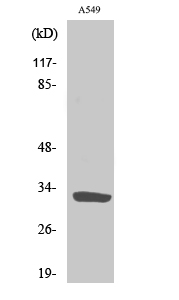ZIP9 Polyclonal Antibody
- SPECIFICATION
- CITATIONS
- PROTOCOLS
- BACKGROUND

Application
| WB |
|---|---|
| Primary Accession | Q9NUM3 |
| Reactivity | Human, Rat |
| Host | Rabbit |
| Clonality | Polyclonal |
| Calculated MW | 32251 Da |
| Gene ID | 55334 |
|---|---|
| Other Names | SLC39A9; ZIP9; Zinc transporter ZIP9; Solute carrier family 39 member 9; Zrt- and Irt-like protein 9; ZIP-9 |
| Dilution | WB~~Western Blot: 1/500 - 1/2000. ELISA: 1/10000. Not yet tested in other applications. |
| Format | Liquid in PBS containing 50% glycerol, 0.5% BSA and 0.09% (W/V) sodium azide. |
| Storage Conditions | -20℃ |
| Name | SLC39A9 (HGNC:20182) |
|---|---|
| Synonyms | ZIP9 |
| Function | Transports zinc ions across cell and organelle membranes into the cytoplasm and regulates intracellular zinc homeostasis (PubMed:19420709, PubMed:25014355, PubMed:28219737). Participates in the zinc ions efflux out of the secretory compartments (PubMed:19420709). Regulates intracellular zinc level, resulting in the enhancement of AKT1 and MAPK3/MAPK1 (Erk1/2) phosphorylation in response to the BCR activation (PubMed:23505453). Also functions as a membrane androgen receptor that mediates, through a G protein, the non- classical androgen signaling pathway, characterized by the activation of MAPK3/MAPK1 (Erk1/2) and transcription factors CREB1 or ATF1 (By similarity). This pathway contributes to CLDN1 and CLDN5 expression and tight junction formation between adjacent Sertoli cells (By similarity). Mediates androgen-induced vascular endothelial cell proliferation through activation of an inhibitory G protein leading to the AKT1 and MAPK3/MAPK1 (Erk1/2) activation which in turn modulate inhibition (phosphorylation) of GSK3B and CCND1 transcription (PubMed:34555425). Moreover, has dual functions as a membrane-bound androgen receptor and as an androgen-dependent zinc transporter both of which are mediated through an inhibitory G protein (Gi) that mediates both MAP kinase and zinc signaling leading to the androgen-dependent apoptotic process (PubMed:25014355, PubMed:28219737). |
| Cellular Location | Golgi apparatus, trans-Golgi network membrane. Cell membrane; Multi-pass membrane protein. Cytoplasm, perinuclear region Mitochondrion. Nucleus |
| Tissue Location | Highly expressed in pancreas, testis, and pituitary and moderately in the kidney, liver, uterus, heart, prostate, and brain, whereas expression is lower in the ovary and colon |

Thousands of laboratories across the world have published research that depended on the performance of antibodies from Abcepta to advance their research. Check out links to articles that cite our products in major peer-reviewed journals, organized by research category.
info@abcepta.com, and receive a free "I Love Antibodies" mug.
Provided below are standard protocols that you may find useful for product applications.
Background
May act as a zinc-influx transporter.
If you have used an Abcepta product and would like to share how it has performed, please click on the "Submit Review" button and provide the requested information. Our staff will examine and post your review and contact you if needed.
If you have any additional inquiries please email technical services at tech@abcepta.com.













 Foundational characteristics of cancer include proliferation, angiogenesis, migration, evasion of apoptosis, and cellular immortality. Find key markers for these cellular processes and antibodies to detect them.
Foundational characteristics of cancer include proliferation, angiogenesis, migration, evasion of apoptosis, and cellular immortality. Find key markers for these cellular processes and antibodies to detect them. The SUMOplot™ Analysis Program predicts and scores sumoylation sites in your protein. SUMOylation is a post-translational modification involved in various cellular processes, such as nuclear-cytosolic transport, transcriptional regulation, apoptosis, protein stability, response to stress, and progression through the cell cycle.
The SUMOplot™ Analysis Program predicts and scores sumoylation sites in your protein. SUMOylation is a post-translational modification involved in various cellular processes, such as nuclear-cytosolic transport, transcriptional regulation, apoptosis, protein stability, response to stress, and progression through the cell cycle. The Autophagy Receptor Motif Plotter predicts and scores autophagy receptor binding sites in your protein. Identifying proteins connected to this pathway is critical to understanding the role of autophagy in physiological as well as pathological processes such as development, differentiation, neurodegenerative diseases, stress, infection, and cancer.
The Autophagy Receptor Motif Plotter predicts and scores autophagy receptor binding sites in your protein. Identifying proteins connected to this pathway is critical to understanding the role of autophagy in physiological as well as pathological processes such as development, differentiation, neurodegenerative diseases, stress, infection, and cancer.


